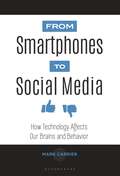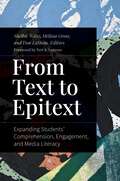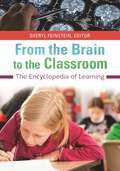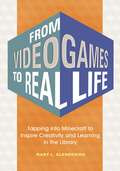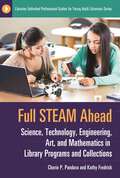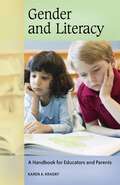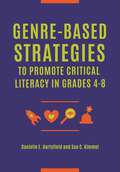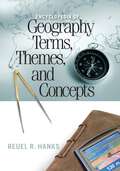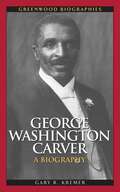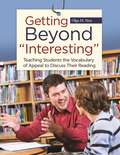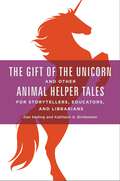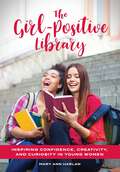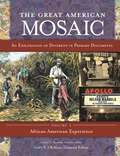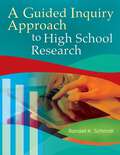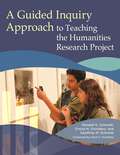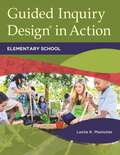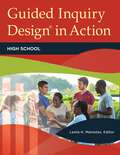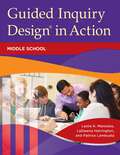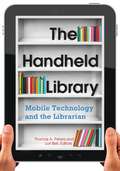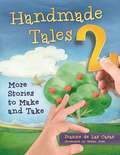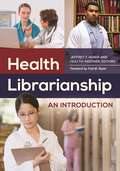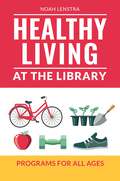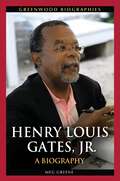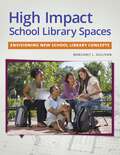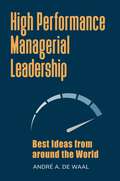- Table View
- List View
From Smartphones to Social Media: How Technology Affects Our Brains and Behavior
by Mark CarrierThis book examines how today's technology, as it includes smartphones, computers, and the internet, shapes our physical health, cognitive and psychological development, and interactions with one another and the world around us.Technology has become a ubiquitous part of modern life, but its impact on our physical, psychological, and social health and development runs just as deep as does our dependence upon it. How is the development of babies' brains affected by their playing with their parents' smartphones and tablets? How have computers altered the way we process and learn information? How have texting and social networking sites such as Facebook changed the way in which we interact with others? Can online dating lead to meaningful real-world relationships? From Smartphones to Social Media investigates these questions and many complex issues related to technology. Readers will discover what researchers know about how the use of technology affects us through accessibly written, thematic chapters. The main text is complemented by a collection of case studies and interviews with a variety of experts, providing insight into how technology's positive and negative effects manifest in our everyday lives and what we can do to mediate the negative ones.
From Text to Epitext: Expanding Students' Comprehension, Engagement, and Media Literacy
by Shelbie Witte, et al.This volume explains how analyzing textual elements that aren't part of the text but connected to it can be used with K–16 students to improve comprehension, engagement, critical thinking, and media literacy.Beginning with an introduction that briefly explains Genette's theory of paratext and discusses the functions of epitext theory, this book comprises theory-to-practice chapters that showcase ways in which teachers and librarians can use elements independent of a text to discuss texts and media with students. Chapters include a practitioner's section specifying practical approaches and explanations for how to use epitext.Scaffolding an application of theory to practice, this title provides educators with an original approach to increasing literacy engagement and integration as well as for increasing media literacy and critical thinking. It includes practical ideas for using epitext in the classroom to promote critical thinking and for collaboration between teachers and librarians. It also includes editorial sidebars that provide additional "how-to" ideas, support deep thinking, make connections to relevant content in other chapters, and provide examples for students in K–16 classrooms.
From the Brain to the Classroom: The Encyclopedia of Learning
by Sheryl FeinsteinSupplying a foundation for understanding the development of the brain and the learning process, this text examines the physical and environmental factors that influence how we acquire and retain information throughout our lives. The book also lays out practical strategies that educators can take directly into the classroom.Comprising more than 100 entries, From the Brain to the Classroom: The Encyclopedia of Learning gathers experts in the fields of education, neuroscience, and psychology to examine how specific areas of the brain work in thought processes, and identifies how educators can apply what neuroscience has discovered to refine their teaching and instructional techniques. The wide range of subjects—organized within the main categories of student characteristics, classroom instructional topics, and learning challenges—include at-risk behaviors; cognitive neuroscience; autism; the lifespan of the brain, from prenatal brain development to the aging brain; technology-based learning tools; and addiction. Any reader who is interested in learning about how the brain works and how it relates to everyday life will find this work fascinating, while educators will find this book particularly helpful in validating or improving their teaching methods to increase academic achievement.
From Video Games to Real Life: Tapping into Minecraft to Inspire Creativity and Learning in the Library
by Mary L. GazdikThis guide shows youth librarians how to use the appeal of Minecraft—a game that many young learners are intensely passionate about—to create engaging library programs that encourage creativity and build STEAM (Science, Technology, Engineering, Arts, and Mathematics) learning through library programs.Minecraft is more than "just a video game"; it's a powerful tool that librarians and other educators can use to engage students and spark legitimate learning experiences. This book shows you how to use Minecraft as a vehicle to promote learning and creativity, supplying specific, easy-to-replicate programs, ideas, and instructions for hands-on activities. By connecting the game to the maker movement and building off the game's popularity, you'll be able to use Minecraft to promote STEAM (Science, Technology, Engineering, Arts, and Mathematics) learning. The book ties Minecraft to maker activities, learning in the library, three-dimensional printing, literary activities, crafting, and more. The activities in this book will also enable you to help children ages 8–14 to expand their key 21st-century skills, such as collaboration, trial and error, and discovery.
Full STEAM Ahead: Science, Technology, Engineering, Art, and Mathematics in Library Programs and Collections (Libraries Unlimited Professional Guides for Young Adult Librarians Series)
by Cherie P. Pandora Kathy FredrickThis book is a toolkit for youth and young adult librarians—school and public—who wish to incorporate science, technology, engineering, art, and math (STEAM) into their programs and collections but aren't sure where to begin.Most educators are well aware of the reasons for emphasizing STEAM—topics that fall within the broad headings of science, technology, engineering, arts, and mathematics—in the curriculum, regardless of grade level. But how do librarians who work with 'tweens in middle school, high school, and public libraries—fit into the picture and play their roles to underscore their relevance in making STEAM initiatives successful? This book answers those key questions, providing program guidelines and resources for each of the STEAM areas. Readers will learn how to collaborate in STEAM efforts by providing information on resources, activities, standards, conferences, museums, programs, and professional organizations. Emphasis is placed on encouraging girls and minorities to take part in and get excited about STEAM. In addition, the book examines how makerspaces can enhance this initiative; how to connect your programs to educational standards; where to find funding; how to effectively promote your resources and programs, including how school and public librarians can collaborate to maximize their efforts; how to find and provide professional development; and how to evaluate your program to make further improvements and boost effectiveness. Whether you are on the cusp of launching a STEAM initiative, or looking for ways to grow and enhance your program, this book will be an invaluable resource.
Gender and Literacy: A Handbook for Educators and Parents (Handbooks for Educators and Parents)
by Karen A. KrasnyThis work offers parents, educators, and librarians a practical guide to discovering the ways gender identities are constructed through literacy practices, providing recommendations for addressing gender inequities in schools and in the community at large.Gender and Literacy: A Handbook for Educators and Parents focuses on issues related to the gendered experience of students from pre-kindergarten through grade 12, promoting an understanding that the issues surrounding gender cannot be reduced to broad generalizations. Author Karen A. Krasny seeks to make clear the complex notion of gender construction within the context of redefining what constitutes legitimate literacy practices in schools.This handbook will help to guide educators, parents, and librarians by assisting them in the selection and evaluation of print and media resources. The first chapter explains the need to understand the complex relationship between gender and literacy. The bulk of the book provides readers with a critical review of the studies conducted to investigate gendered literacy practices, while the last three chapters focus on actionable strategies and policy making.
Genre-Based Strategies to Promote Critical Literacy in Grades 4–8
by Danielle E. Hartsfield Sue C. KimmelDraws on critical and radical change theory to equip both aspiring and practicing library and teacher candidates with practical, research-based ideas for enacting critical literacy practices in middle grade libraries and classrooms.Genre Based Strategies to Promote Critical Literacy in Grades 4-8 provides strategies and lesson plans with additional resources and tools for school librarians and teachers to engage middle grade students in reading children's literature through a critical literacy lens. To be critically literate readers and thinkers, students must learn to question what they read, asking themselves who wrote the text, why the text was written, and how the text positions its readers and others. Teaching students how to read from a critical literacy stance is a timely and relevant practice in a world in which text is available instantly and on nearly any mobile device. In many cases, preparation programs for school librarians and teachers do not teach candidates how to incorporate critical literacy practices in library and classroom settings. This book provides both pre-service and in-service school librarians and teachers with that professional development and guidance for teaching critical literacy in children's literature courses.
Encyclopedia of Geography Terms, Themes, and Concepts
by Reuel R. HanksThis text provides an essential reference handbook for students of geography and related social sciences.How did the Greek geographer Eratosthenes make an accurate calculation of the earth's circumstance more than 1,500 years before the first voyage of Columbus to the New World? What are the "green belts" of England that dominate its rural landscape? And what is regarded as the driest continent on the planet?This handbook offers a broad coverage of terminology and concepts, serving as both an encyclopedic dictionary of geography terms and an approachable overview to the human and physical aspects of world geography. Approximately 150 geographic terms and concepts are defined and discussed, providing an accessible reference for anyone who requires a deeper knowledge of the language and ideas that are important to geography as a discipline. Helpful sidebars are provided to shed light on unusual or controversial theories and concepts. All major geographic concepts and terms are addressed and comprehensively explained using examples.
George Washington Carver: A Biography (Greenwood Biographies)
by Gary R. KremerThis book strips away the myths surrounding the famed scientist George Washington Carver and portrays him as a brilliant, creative man who nonetheless possessed very human peculiarities and frailties.This insightful work chronicles the life of George Washington Carver, the renowned African American scientist and teacher. George Washington Carver: A Biography begins with a discussion of the political and social circumstances in Missouri where Carver was born into slavery, circa 1864. Readers will follow Carver through his formal education to his decision to accept Booker T. Washington's offer to teach and do research at the Tuskegee Institute in Alabama.The bulk of the volume focuses on Carver's career at Tuskegee, a career that spanned nearly five decades, from 1896 until Carver's death in January 1943.The book highlights Carver's major achievements, including his championing of crop rotation and the hundreds of products he created from peanuts, sweet potatoes, and other plants native to the South. In addition to Carver the scientist, students will meet Carver the man, who, for example, loved art and painted throughout his life.
Getting Beyond "Interesting": Teaching Students the Vocabulary of Appeal to Discuss Their Reading
by Olga M. NesiMake use of a detailed plan and ready-to-use lessons for teaching appeal terms and Book Hook writing to students.Getting Beyond "Interesting": Teaching Students the Vocabulary of Appeal to Discuss Their Reading is a practical application book that gives librarians all the tools they need to implement the teaching of both appeal terms and Book Hook writing and sharing. When students know how to write Book Hooks and have access to an easy-to-use system for allowing students to share Book Hooks, the result is greatly increased reading through the power of peer recommendations.This book not only supplies a detailed plan for teaching appeal terms and Book Hook writing, but it also provides two extensive appendices containing all the black line masters and forms needed to implement these lessons. As a result, practitioners will be able to enhance their students' reading culture through increased sharing of reading—and most importantly, by empowering students with the ability to clearly define their reading preferences.
The Gift of the Unicorn and Other Animal Helper Tales for Storytellers, Educators, and Librarians
by Dan Keding Kathleen A. BrinkmannEngage young readers in stories they love while teaching important content with this fun book that features more than 40 folktales from around the world celebrating the animal-human bond.Written by two leaders in the field of storytelling, this compilation of folktales—all retold for elementary readers—emphasizes the admirable qualities of animal-human relationships. Stories source from folktale collections, oral histories, and science and sociology books from around the world and include learning opportunities for taking a stand against bullies, understanding wild and domestic animal habitats, and appreciating nature. Additionally, you'll be able to introduce readers to new cultures, providing a springboard for learning about other people and their ways of life.Each story is accompanied by information that identifies the country or culture of origin, sources, and interesting background facts. Exercises, questions, and suggestions promote further study and help engage readers in what they have learned. The organization of sections of stories on creatures of land, sky, sea, and water; imaginary animals; and crews of animals working together makes it easy to find what suits your audience best.
The Girl-Positive Library: Inspiring Confidence, Creativity, and Curiosity in Young Women
by Mary Ann HarlanProviding a model of critique useful in readers advisory, collection development, and book clubs, this title encourages the inclusion of young adult titles advancing a positive representation of girls in programming and instruction.Even in an era in which there are multiple and wide-ranging conversations about representations of diverse groups in literature, the depiction of girls in young adult literature has received inadequate attention. This text provides a model for understanding how girls are represented in young adult literature that will aid school and youth services librarians in their personal understanding and awareness as they build collections and create programming.It provides practical suggestions for how to use and implement a feminist lens while reading, discussing, and reviewing titles. Included are a list of recommended annotated titles and discussion questions for use in developing appropriate instructional and interesting programs that explore concepts of girlhood, media literacy programs, and diverse collections.
The Great American Mosaic [4 volumes]: An Exploration of Diversity in Primary Documents [4 volumes]
by Gary Y. OkihiroFirsthand sources are brought together to illuminate the diversity of American history in a unique way—by sharing the perspectives of people of color who participated in landmark events.This invaluable, four-volume compilation is a comprehensive source of documents that give voice to those who comprise the American mosaic, illustrating the experiences of racial and ethnic minorities in the United States. Each volume focuses on a major racial/ethnic group: African Americans, American Indians, Asian Americans and Pacific Islanders, and Latinos. Documents chosen by the editors for their utility and relevance to popular areas of study are organized into chronological periods from historical to contemporary. The collection includes eyewitness accounts, legislation, speeches, and interviews. Together, they tell the story of America's diverse population and enable readers to explore historical concepts and contexts from multiple viewpoints. Introductions for each volume and primary document provide background and history that help students understand and critique the material. The work also features a useful primary document guide, bibliographies, and indices to aid teachers, librarians, and students in class work and research.
A Guided Inquiry Approach to High School Research (Libraries Unlimited Guided Inquiry)
by Randell K. SchmidtThis book helps educators foster academic success and college readiness: it demonstrates how to instruct high school students to find, process, and think about new information, and then synthesize that knowledge.When students are able to manage topics of high interest by choosing their own subject matter, they learn how to effectively perform pre-collegiate research through a process that they find fun and rewarding. Ideal for high school-level teachers and school librarians, this book provides a unique, holistic approach to guided inquiry that guides students step-by-step through the cognitive, affective, and social processes involved, building critical study skills, time management strategies, collaboration techniques, and communication and presentation skills.A Guided Inquiry Approach to High School Research is derived from a formal research protocol and provides proven techniques and supporting materials that facilitate the process for permitting students to choose their own topic, easily grasping how to search for information, and successfully completing a seemingly daunting research assignment—a process that makes understandings deep and integrative. The included detailed project lessons, student handouts, and rubrics and assessment tools are the result of many years of classroom testing and refinement.
A Guided Inquiry Approach to Teaching the Humanities Research Project (Libraries Unlimited Guided Inquiry)
by Randell K. Schmidt Emilia N. Giordano Geoffrey M. SchmidtAligned with the Common Core, this book enables teachers and librarians to develop lessons and workshops as well as to teach high school students how to research and write a humanities paper using a guided inquiry approach.Being able to use the inquiry process to successfully research, write, and prepare papers and others types of presentations is not only necessary for a student's preparation for collegiate work, but is truly a requisite life skill. This book provides a solid guided inquiry curriculum for cultivating the skills needed to properly investigate a subject in the humanities, interrogate both textual and non-textual sources, interpret the information, develop an understanding of the topic, and effectively communicate one's findings. It is a powerful and practical guide for high school humanities teachers, school librarians, community college humanities teachers and librarians, and early college-level humanities instructors as well as for high school and college students who want to learn how to conduct and write up humanities research.Part one comprises a teacher's practicum that explains the power of guided inquiry. Part two contains student's workshops with instructions and materials to conduct a guided humanities project and paper on the high school level. The third part provides materials for a professional development session for this assignment as well as assessment tools and other supplementary materials such as student handouts. Based on the authors' 15 years' experience in teaching guided inquiry, the 20 workshops in the book use a step-by-step, constructivist strategy for teaching a sophisticated humanities project that enables college readiness.
Guided Inquiry Design® in Action: Elementary School (Libraries Unlimited Guided Inquiry)
by Leslie K. ManiotesThis book explores Guided Inquiry Design®, a simple, practical model that addresses all areas of inquiry-based learning and sets the foundation for elementary-age students to learn more deeply.One of three needed for district-wide implementation of GID at all levels, K-12, this book provides an introduction to an educational method that embeds information literacy into content areas and encourages students to acquire a more intimate knowledge of subjects through asking questions and conducting more thorough research. Intended to be used alongside Guided Inquiry Design®, lessons are laid out using the GID session plan templates from Guided Inquiry Design®. Readers can implement these lessons as they are or use them as models in designing their own, similar units customized for their own local or school population and to meet relevant standards and content. Included in these lesson plans are lessons created by educators for increased student interaction that enhance the elementary educator's ability to instruct younger students using the GID process.
Guided Inquiry Design® in Action: High School (Libraries Unlimited Guided Inquiry)
by Leslie K. ManiotesEdited by the cocreator of the Guided Inquiry Design® (GID) framework as well as an educator, speaker, and international consultant on the topic, this book explains the nuances of GID in the high school context. It also addresses background research and explains guided inquiry and the information search process.Today's students need to be able to think creatively to solve problems. They need to be in learning environments that incorporate collaboration, discussion, and genuine reflection to acquire these kinds of real-world skills. Guided Inquiry Design® in Action: High School gives teachers and librarians lesson plans created within the proven GID framework, specifically designed for high school students, and provides the supporting information and guidance to use these lesson plans successfully.You'll find the lesson plans and complete units of Guided Inquiry Design® clear and easy to implement and integrate into your existing curriculum, in all areas, from science to humanities to social studies. These teaching materials are accompanied by explanations of critical subjects such as the GID framework, using Guided Inquiry as the basis for personalized learning, using inquiry tools for assessment of learning in high school, and applying teaching strategies that increase student investment and foster critical thinking and deeper learning.
Guided Inquiry Design® in Action: Middle School (Libraries Unlimited Guided Inquiry)
by Leslie K. Maniotes LaDawna Harrington Patrice LambustaSupplying classroom-tested lessons and unit plans that can serve as templates, this book demonstrates exactly how to integrate and implement Guided Inquiry Design® (GID) theory into practice.Guided Inquiry is an approach that many educators—thought leaders and practitioners alike—are finding to be well-suited to information-age learning and a way to meet Common Core Standards. For many teachers, librarians, middle school leaders, and curriculum specialists, the biggest challenge is finding examples of guided inquiry in practice applicable to their own context. This guide offers an easy solution, offering ready-to-use templates and models for implementing Guided Inquiry Design® (GID) in the middle school learning environment. With each supplied lesson laid out according to the session plan templates from GID and a thorough description of the ideal inquiry process from beginning to end, integration and implementation of GID is attainable.Besides showing how to put GID to best use to achieve five kinds of learning through inquiry, the book provides an explicit structure for developing instructional partnerships and collaborative teams within the school and with the larger community. It enables teachers, school librarians, and other educational partners to consider and plan for achieving outcomes that bring about deep understanding while also addressing curricular goals. Readers will be better equipped to provide an authentic learning environment using collaboration, discussion, and reflection embedded in the sessions, thereby helping their students to be able to think creatively to solve problems.
The Handheld Library: Mobile Technology and the Librarian
by Thomas A. Peters and Lori BellCovering topics such as mobile reference, eBooks, mobile websites, and QR codes, this book examines the effects of the global mobile revolution on libraries and library users—critical information all librarians need.The Handheld Library: Mobile Technology and the Librarian provides the information and guidance librarians need to adapt themselves and their facilities to the mobile revolution—the fastest, most diffuse worldwide technological innovation in human history.The book provides an up-to-date survey of how mobile technologies are affecting library use, library services, library systems, librarians, and library users at various types of libraries. The authors cover core topics related to mobile libraries, including mobile reference, eBooks, mobile websites, and QR codes, and address aspects of the mobile revolution less frequently covered in the literature, such as mobile health information services, the use of mobile technologies on archival work, the impact of the mobile revolution on physical libraries, and the ways in which new mobile technologies are creating professional development opportunities within the profession. While this resource is specifically targeted toward librarians who plan and provide services using mobile technologies, academic, public, and other librarians will also find the ideas and information within useful.
Handmade Tales 2: More Stories to Make and Take
by Dianne de CasasChildren love seeing ordinary objects such as paper and string transformed into extraordinary things. This book provides a collection of fun make-and-take tales that enable educators and librarians to take storytelling to a higher level.Can something as simple as a handkerchief, rubber band, paper plate, or piece of rope be used to captivate children during a storytelling? An expansion of the original, best-selling Handmade Tales book, author and storyteller Dianne de Las Casas provides 25 more clever handmade tales appropriate for pre-kindergarten to third grade. By following her clear instructions on incorporating inexpensive props comprised of everyday items into these fun make-and-take stories, educators and librarians can exponentially expand the appeal of their storytime efforts.Including different types of make-and-take stories like string stories, draw and tell, paper tales, and stories that use other simple props, the handmade tales in this book are ideal for preschool and elementary school teachers and librarians of all experience levels. Storytellers, scout leaders, camp counselors, and others who work with groups of young children will also find these make-and-take stories and instructions invaluable.
Health Librarianship: An Introduction
by Jeffrey T. Huber Feili Tu-Keefner James E. Andrews Keith Cogdill Prudence W. Dalrymple Melissa De Santis Michael A. Flannery Sandra G. Franklin Julie K. Gaines Anna Getselman Mary L. Gillaspy Gerald Perry Connie Schardt Katherine Schilling Robert Shapiro Denise Shereff Meredith Solomon Michele A. Spatz Susan Swogger Fay J. Towell Douglas L. VarnerIntended for students interested in careers as health sciences librarians, this insightful book presents a current view of trends and issues in the field of health librarianship from leading scholars and practitioners.With health care reform and the Affordable Care Act driving up demand for ready access to health and biomedical information by both health care providers and healthcare consumers, health librarianship plays a critical role in facilitating access to that information. Health Librarianship: An Introduction places health librarianship within the health care context, covering librarianship within this specific environment as well as other perspectives relevant to health librarianship. The book addresses the basic functions of librarianship—for example, management and administration, public services, and technical services—within the health care context as well as issues unique to health librarianship like health literacy, consumer health, and biomedical informatics. This book is an outstanding textbook for library and information sciences classes and will also be of interest to those considering a career change to health librarianship.
Healthy Living at the Library: Programs for All Ages
by Noah LenstraThis broad-ranging resource is for librarians who want to begin a new program or incorporate healthy living into an existing one.From garden plots to cooking classes to StoryWalks to free yoga, more and more libraries are developing innovative programs and partnerships to encourage healthy living. Libraries increasingly provide health and wellness programs for all ages and abilities, and Healthy Living at the Library is intended for library staff of all types who want to offer programs and services that foster healthy living, particularly in the domains of food and physical activity. Author Noah Lenstra, who has extensive experience directing and advising on healthy living programs, first outlines steps librarians should take when starting programs, highlighting the critical role of community partnerships. The second section of the book offers detailed instructions for running different types of programs for different ages and abilities. A third section includes advice on keeping the momentum of a program going and assessing program impacts. Lenstra offers tips on how to overcome challenges or roadblocks that may arise. An appendix contains resources you can adapt to get these programs off the ground, including waivers of liability, memoranda of understanding, and examples of strategic plans and assessment tools.
Henry Louis Gates, Jr.: A Biography (Greenwood Biographies)
by Meg GreeneThis full-length biography explores the multifaceted—and altogether fascinating—life, opinions, and accomplishments of African American scholar and writer Henry Louis Gates, Jr.Henry Louis Gates, Jr.: A Biography is the first comprehensive volume about a man hailed as one of America's most influential scholars. Tracing Gates's life from his West Virginia birth, the book follows him through his undergraduate education at Yale and then to Cambridge, where he became the first African American to receive a doctorate. His current activities as a Harvard University professor, director of the W.E.B. Du Bois Institute for African and African American Research, and editor-in-chief of TheRoot.com, a daily, online magazine focusing on issues of interest to the African American community, are explored as well.The biography also provides insights into Gates's groundbreaking work as a critic, scholar, and author, probing his wide-ranging interests, his many accomplishments, and his invaluable revelations about the contributions of African Americans to the nation's literature and history. Most important, the book provides readers with a fuller understanding of African American history and literature—and of the nature of today's racial politics.
High Impact School Library Spaces: Envisioning New School Library Concepts
by Peg L. SullivanTo keep school libraries relevant, their physical spaces need to be reinvented to mirror 21st-century learning models. This book will enable everyone from school librarians and principals to district-level administrators, architects, and interior planners of school library spaces to reconceptualize school libraries.School libraries provide invaluable benefits and services, but many of today's school administrators, parents, and students no longer see their value. Now most students have their own computing devices and the use of eBooks is on the rise; students can gather information anywhere, at any time. This book offers bold new ways to think about library spaces and suggests how libraries can provide the spaces needed to encourage students to explore learning. It also presents librarians with dynamic ideas and plans that can be used as a springboard for planning with school administrators, architects, and builders.The book identifies opportunities for creating spaces that support instructional models such as guided inquiry, examines technology skills needed after graduation, shows digital media hubs complementing maker spaces, and discusses how incorporating social media spaces into library design can encourage learning. The author guides librarians through the process of documenting the district learning goals in order to translate those specific goals into library space plans for an architect or interior designer. Readers will discover templates for flexible, up-to-date library designs that serve to not only improve students' learning and critical thinking skills but also to emphasize the modern school librarian's role in boosting academic achievement.
High Performance Managerial Leadership: Best Ideas from around the World
by André A. WaalLearn how managers have transformed their teams and companies into envied high-performance organizations in this guide to nurturing successful managers at your organization, informed by the author's 10-year study of applications of his High Performing Organization (HPO) Framework.How can an organization learn to perform at a high level? The key is management. Based on years of intensive research and experience, André de Waal's proven strategy for achieving positive organizational change can turn your company or team into a true High Performance Organization (HPO). De Waal's HPO Framework is the only management improvement technique that has been developed on a solid scientific basis, validated through longitudinal site-level research, and developed over years of measuring organizational results. In this book, de Waal focuses on the activities and behaviors of managers in organizations that have successfully transformed themselves into HPOs. The author and his team closely followed and measured organizations that have adopted and applied the HPO Framework over many years, uncovering the secrets to creating successful and transformative managers through the use of HPO coaches, the application of "silo-busting" techniques to spur collaboration, and use of the HPO transformation success wheel.The resulting data set, analytics, and lessons presented represent a treasure trove of actionable tools for achieving successful managerial and organizational change and improvement.
